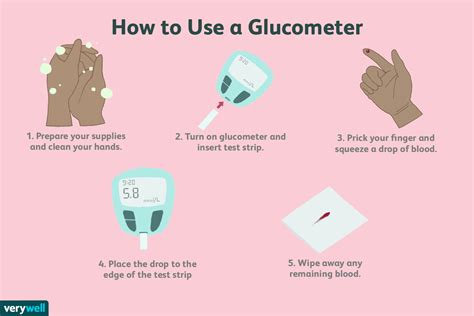Measuring blood glucose levels is a crucial aspect of managing diabetes, allowing individuals to monitor their condition, make informed decisions about their diet and exercise, and adjust their medication as needed. The process involves pricking a fingertip with a lancet to draw a small blood sample, which is then placed on a test strip and inserted into a blood glucose meter. However, understanding the units of measurement is essential for interpreting the results accurately.
Understanding Blood Glucose Units
Blood glucose levels are typically measured in milligrams per deciliter (mg/dL) in the United States and millimoles per liter (mmol/L) in most other countries. To convert mg/dL to mmol/L, you divide the mg/dL value by 18. For example, a blood glucose level of 180 mg/dL is equivalent to 10 mmol/L. Familiarizing yourself with these units and their conversion is vital for interpreting your blood glucose readings correctly.
Steps to Measure Blood Glucose
Prepare Your Meter and Test Strip: Ensure your blood glucose meter is calibrated and ready for use. Take a test strip from the container and insert it into the meter according to the manufacturer’s instructions.
Wash Your Hands: Clean your hands with soap and water to prevent any residue from interfering with the test results.
Choose a Fingertip: Select a fingertip that is less likely to be sore. Rotate fingertips to avoid consistent pressure on the same spot.
Lance the Fingertip: Use a lancet device to prick the side of the fingertip. This area is less sensitive and can provide a better blood sample.
Obtain a Blood Sample: Gently massage the finger from the base towards the tip to help the blood flow. When a drop of blood forms, touch it to the test strip. Some meters may have a setting for different sample sizes.
Read the Results: The meter will display your blood glucose level after a few seconds. Record the result, along with the date, time, and any relevant notes (such as the time of your last meal).
Tips for Accurate Readings
- Use the Correct Technique: Properly placing the blood sample on the test strip is crucial. Refer to the meter’s instructions for guidance.
- Check the Expiration Date: Ensure the test strips are not expired, as this can affect the accuracy of your readings.
- Maintain Your Meter: Regularly clean and calibrate your meter as instructed by the manufacturer.
- Monitor at the Right Times: Checking your blood glucose levels at various times of the day (e.g., before meals, after meals, and before bedtime) can provide valuable insights into how different factors affect your blood glucose levels.
- Keep a Log: Record your readings in a log or use an app to track your blood glucose levels over time. This can help identify patterns and make adjustments to your diabetes management plan.
Interpreting Blood Glucose Levels
Interpreting your blood glucose readings involves understanding what levels are considered normal, elevated, or dangerous. Generally: - Normal Fasting: Less than 100 mg/dL (5.6 mmol/L) - Impaired Fasting Glucose: 100 mg/dL to 125 mg/dL (5.6 to 6.9 mmol/L) - Diabetes: 126 mg/dL or higher (7.0 mmol/L or higher) - Before Meals: Less than 130 mg/dL (7.2 mmol/L) for most adults - After Meals: Less than 180 mg/dL (10.0 mmol/L) for most adults
These values are general guidelines and may vary depending on your individual health goals and needs, as well as the recommendations of your healthcare provider.
Conclusion
Measuring blood glucose units accurately is a fundamental skill for diabetes management. By following the steps outlined above, understanding the measurement units, and interpreting the results, individuals can better manage their condition. It’s also crucial to work closely with a healthcare provider to set personal targets for blood glucose levels and to understand how to use this information to make informed decisions about diet, exercise, and medication. With practice and the right guidance, managing blood glucose levels becomes more intuitive, enabling those with diabetes to lead active and healthy lives.
What is the normal range for blood glucose levels after eating?
+Generally, the target for most adults after eating is to have a blood glucose level less than 180 mg/dL (10.0 mmol/L). However, these targets can vary based on individual factors and should be discussed with a healthcare provider.
Why is it important to rotate the fingertips used for blood glucose testing?
+Rotating the fingertips helps to avoid consistent pressure and potential soreness on the same spot. The sides of the fingertips are less sensitive and can provide a better blood sample, making them preferable for testing.
How often should I check my blood glucose levels?
+The frequency of checking blood glucose levels can vary depending on the individual's diabetes management plan, the type of diabetes, and other factors. Typically, checking before meals, after meals, and before bedtime can provide valuable insights, but the best schedule should be determined in consultation with a healthcare provider.
By combining accurate blood glucose measurement with a comprehensive understanding of diabetes management, individuals can maintain better control over their condition and reduce the risk of complications. Remember, managing diabetes is a long-term process that requires patience, adherence to a management plan, and ongoing education about the latest in diabetes care.



